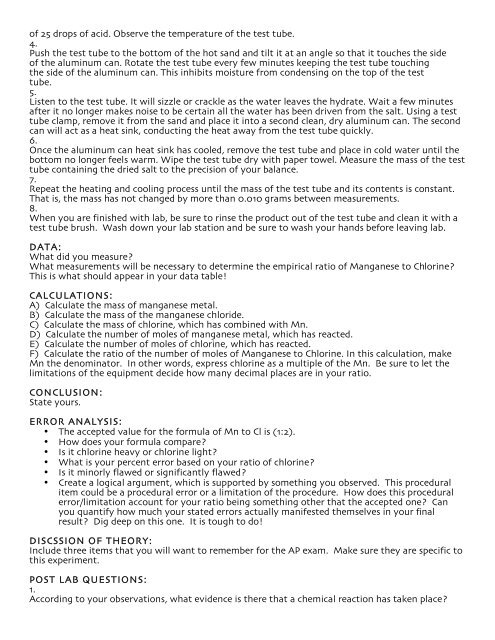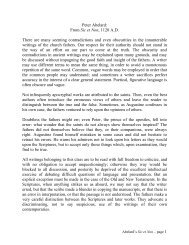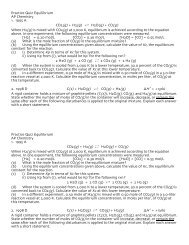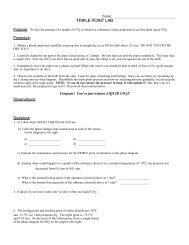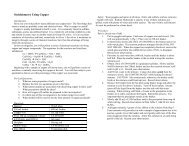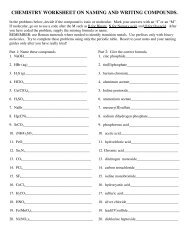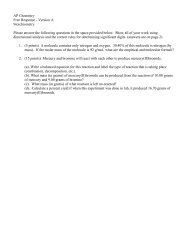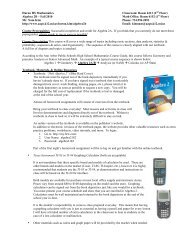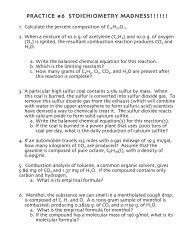Law of Multiple and Definite Proportions
Law of Multiple and Definite Proportions
Law of Multiple and Definite Proportions
Create successful ePaper yourself
Turn your PDF publications into a flip-book with our unique Google optimized e-Paper software.
<strong>of</strong> 25 drops <strong>of</strong> acid. Observe the temperature <strong>of</strong> the test tube.<br />
4.<br />
Push the test tube to the bottom <strong>of</strong> the hot s<strong>and</strong> <strong>and</strong> tilt it at an angle so that it touches the side<br />
<strong>of</strong> the aluminum can. Rotate the test tube every few minutes keeping the test tube touching<br />
the side <strong>of</strong> the aluminum can. This inhibits moisture from condensing on the top <strong>of</strong> the test<br />
tube.<br />
5.<br />
Listen to the test tube. It will sizzle or crackle as the water leaves the hydrate. Wait a few minutes<br />
after it no longer makes noise to be certain all the water has been driven from the salt. Using a test<br />
tube clamp, remove it from the s<strong>and</strong> <strong>and</strong> place it into a second clean, dry aluminum can. The second<br />
can will act as a heat sink, conducting the heat away from the test tube quickly.<br />
6.<br />
Once the aluminum can heat sink has cooled, remove the test tube <strong>and</strong> place in cold water until the<br />
bottom no longer feels warm. Wipe the test tube dry with paper towel. Measure the mass <strong>of</strong> the test<br />
tube containing the dried salt to the precision <strong>of</strong> your balance.<br />
7.<br />
Repeat the heating <strong>and</strong> cooling process until the mass <strong>of</strong> the test tube <strong>and</strong> its contents is constant.<br />
That is, the mass has not changed by more than 0.010 grams between measurements.<br />
8.<br />
When you are finished with lab, be sure to rinse the product out <strong>of</strong> the test tube <strong>and</strong> clean it with a<br />
test tube brush. Wash down your lab station <strong>and</strong> be sure to wash your h<strong>and</strong>s before leaving lab.<br />
DATA:<br />
What did you measure?<br />
What measurements will be necessary to determine the empirical ratio <strong>of</strong> Manganese to Chlorine?<br />
This is what should appear in your data table!<br />
CALCULATIONS:<br />
A) Calculate the mass <strong>of</strong> manganese metal.<br />
B) Calculate the mass <strong>of</strong> the manganese chloride.<br />
C) Calculate the mass <strong>of</strong> chlorine, which has combined with Mn.<br />
D) Calculate the number <strong>of</strong> moles <strong>of</strong> manganese metal, which has reacted.<br />
E) Calculate the number <strong>of</strong> moles <strong>of</strong> chlorine, which has reacted.<br />
F) Calculate the ratio <strong>of</strong> the number <strong>of</strong> moles <strong>of</strong> Manganese to Chlorine. In this calculation, make<br />
Mn the denominator. In other words, express chlorine as a multiple <strong>of</strong> the Mn. Be sure to let the<br />
limitations <strong>of</strong> the equipment decide how many decimal places are in your ratio.<br />
CONCLUSION:<br />
State yours.<br />
ERROR ANALYSIS:<br />
• The accepted value for the formula <strong>of</strong> Mn to Cl is (1:2).<br />
• How does your formula compare?<br />
• Is it chlorine heavy or chlorine light?<br />
• What is your percent error based on your ratio <strong>of</strong> chlorine?<br />
• Is it minorly flawed or significantly flawed?<br />
• Create a logical argument, which is supported by something you observed. This procedural<br />
item could be a procedural error or a limitation <strong>of</strong> the procedure. How does this procedural<br />
error/limitation account for your ratio being something other that the accepted one? Can<br />
you quantify how much your stated errors actually manifested themselves in your final<br />
result? Dig deep on this one. It is tough to do!<br />
DISCSSION OF THEORY:<br />
Include three items that you will want to remember for the AP exam. Make sure they are specific to<br />
this experiment.<br />
POST LAB QUESTIONS:<br />
1.<br />
According to your observations, what evidence is there that a chemical reaction has taken place?


